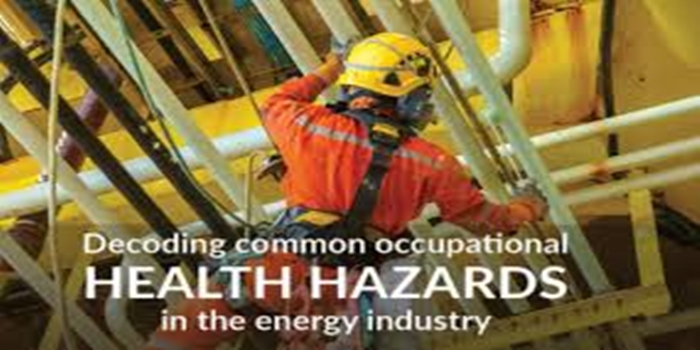In this article, occupational health in Oil and Gas, Categories of Occupational Health Risks in Oil and Gas Jobs,
Definition
Occupational health is an area of work in public health to promote and maintain highest degree of physical, mental and social well-being of workers in all occupations.
Occupational health risks in the oil and gas sector can stem from physical hazards, chemical exposure, ergonomic strain, psychological stress, and long-term chronic illnesses. These risks vary depending on the type of job, location (onshore vs. offshore), and the specific segment of the industry (upstream, midstream, or downstream).
Occupational health focuses on promoting and maintaining the highest degree of physical, mental, and social well-being of workers in all occupations. In oil and gas, this involves:
Identifying workplace hazards
Monitoring exposure to harmful substances
Implementing health surveillance programs
Providing medical support and emergency care
Promoting mental health and wellness
Categories of Occupational Health Risks in Oil and Gas Jobs:
Chemical Hazards
Toxic Gases and Vapors:
Exposure to substances like benzene (a known carcinogen) and hydrogen sulfide can cause respiratory problems, organ damage, and other health issues.
Fumes and Dust:
Working in enclosed spaces or with certain processes exposes workers to airborne irritants and toxins.
Physical Hazards
Noise:
High noise levels from heavy machinery and equipment can lead to hearing loss.
Heat Stress:
Working in warm, humid conditions, especially with physical exertion, can cause heat discomfort and more severe heat-related illnesses.
Pressure:
Workers may be exposed to high-pressure lines and equipment, which can pose risks of explosions or leaks.
Vibration:
Extended use of heavy machinery can contribute to musculoskeletal problems and nerve damage.
Falls:
Working at heights on rigs, or on slippery surfaces, presents a high risk of severe falls, fractures, and fatalities.
Ergonomic Hazards
Repetitive Motion:
Tasks involving repetitive movements can lead to muscle strains, tendinitis, and other musculoskeletal conditions.
Heavy Lifting:
The use of heavy machinery and manual handling of heavy materials can cause back, neck, and shoulder pain, as well as other injuries.
Psychosocial Hazards
Stress:
Demanding work environments, long shifts, and the inherent risks of the job can lead to stress and other mental health challenges.
Fatigue:
Long shifts and travel to remote work sites can contribute to worker fatigue and increase the risk of accidents.
Biological Hazards
While less common, workers can sometimes be exposed to biological hazards, such as microbes or bacteria in contaminated areas, which can lead to infections.
Preventive Measures and Best Practices
- Risk Identification and Assessment
Conduct regular Job Hazard Analyses (JHAs).
Use Health Risk Assessments (HRAs) to determine exposure levels.
- Engineering and Administrative Controls
Install ventilation systems, noise dampeners, and automated machinery.
Implement rotation schedules, job redesign, and rest breaks.
- Personal Protective Equipment (PPE)
Use appropriate PPE: respirators, gloves, flame-resistant clothing, earplugs, and eye protection.
Ensure proper PPE training and maintenance.
- Health Surveillance and Monitoring
Regular medical check-ups and exposure monitoring (e.g., air quality testing).
Biometric screening for early detection of chronic illnesses.
- Emergency Response Plans
Prepare for H₂S leaks, fires, chemical spills, and medical emergencies.
Train workers in first aid, evacuation, and hazard recognition.
- Mental Health Support
Offer Employee Assistance Programs (EAPs).
Promote mental health literacy, peer support, and open communication.
Improve work-life balance, especially for rotational staff.
Roles and Functions:
Public Safety:
Regulations and standards aim to protect the health, safety, and property of the public by minimizing risks and ensuring that products, services, and processes meet certain safety thresholds.
Quality and Consistency:
They establish clear criteria, methods, and practices to promote uniformity, consistency, and high quality in products, services, and operations across different organizations and sectors.
Environmental Protection:
Regulations and standards often mandate practices to prevent pollution, manage hazardous waste, and conserve resources, contributing to environmental sustainability and the protection of human health from harmful chemicals.
Fair Competition:
They can promote fair competition by providing a level playing field and preventing unfair or unethical practices that could disadvantage consumers or other businesses.
Consumer Protection:
By ensuring quality, safety, and providing clear information, standards and regulations give consumers confidence that they are receiving good value and are not being subjected to substandard or risky offerings.
Accountability and Trust:
A clear framework of regulations and standards builds public confidence by ensuring that organizations and individuals are held accountable for meeting agreed-upon requirements.
How They Work:
Governing Bodies:
Regulations are typically set by government or authorized bodies, while standards can be established by industry associations, international organizations, or national bodies.
Compliance Frameworks:
These rules and guidelines form a framework that entities must adhere to in their operations, development, and manufacturing processes.
Enforcement Mechanisms:
Non-compliance can lead to consequences such as financial penalties, suspension or revocation of licenses, legal liabilities, and damage to an organization’s reputation.
Health Risk Variations Across Segments
Upstream (Exploration & Production)
High risk of exposure to H₂S, drilling fluids, silica dust.
Manual labor leads to physical and ergonomic injuries.
Remote locations heighten isolation and limit medical access.
Midstream (Transportation & Storage)
Risk includes pipeline leaks, confined space entry, and fire/explosion hazards.
Workers often exposed to diesel exhaust and noise.
Downstream (Refining & Distribution)
Chemical exposure is significant, especially to VOCs and corrosive substances.
Ergonomic strain from maintenance tasks and inspections.
Conclusion
Occupational health risks in oil and gas jobs are varied, complex, and potentially severe. From physical injuries and toxic exposures to psychological stress and chronic disease, these hazards require a systematic, multidisciplinary approach to prevent and manage effectively.
READ: Virtual Reality in Healthcare


